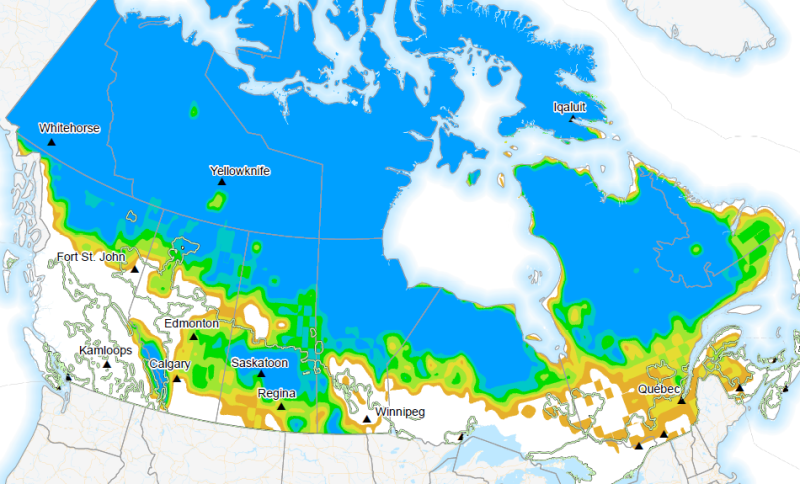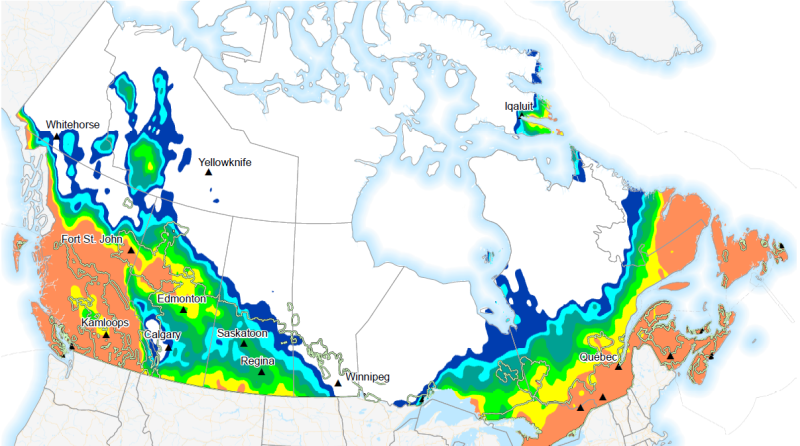climatologyMeteorologyAtmosphere
Type of resources
Available actions
Topics
Keywords
Contact for the resource
Provided by
Years
Formats
Representation types
Update frequencies
status
Scale
Resolution
-

Gögnin innhalda staðsetningu veðurstöðva sem eru í eigu Vegagerðarinnar og staðsettar eru við þjóðvegi en einnig veðurstöðvar í eigu Veðurstofunnar og annarra.
-

The Probability (likelihood) of frost occurring. The number of days in the forecast period with a minimum temperature below the frost temperature, the temperature at which frost damage occurs. This temperature is -2°C for cool season crops (ffd_cool_prob). Week 1 and week 2 forecasted probability is available daily from April 1 to October 31. Week 3 and week 4 forecasted probability is available weekly (Thursday) from April 1 to October 31. Cool season crops require a relatively low temperature condition. Typical examples include wheat, barley, canola, oat, rye, pea, and potato. They normally grow in late spring and summer, and mature between the end of summer and early fall in the southern agricultural areas of Canada. The optimum temperature for such crops is 25°C. Agriculture and Agri-Food Canada (AAFC) and Environment and Climate Change Canada (ECCC) have together developed a suite of extreme agrometeorological indices based on four main categories of weather factors: temperature, precipitation, heat, and wind. The extreme weather indices are intended as short-term prediction tools and generated using ECCC’s medium range forecasts to create a weekly index product on a daily and weekly basis.
-
Growing Degree Days (GDDs) are used to estimate the growth and development of plants and insects during the growing season. Insect and plant development are very dependent on temperature and the daily accumulation of heat. The amount of heat required to move a plant or pest to the next development stage remains constant from year to year. However, the actual amount of time (days) can vary considerably from year to year because of weather conditions. Base temperatures are a point below which development does not occur for the organism in question. Base 15 temperatures are commonly used for general insect development. These values are calculated across Canada in 10x10 km cells.
-

Maximum Temperature represents the highest recorded temperature value (°C) at each location for a given time period. Time periods include the previous 24 hours and the previous 7 days from the available date where a climate day starts at 0600UTC.
-
Seasonal and annual multi-model ensembles of projected relative change (also known as anomalies) in mean precipitation based on an ensemble of twenty-nine Coupled Model Intercomparison Project Phase 5 (CMIP5) global climate models are available for 1901-2100. Projected relative change in mean precipitation is with respect to the reference period of 1986-2005 and expressed as a percentage (%). The 5th, 25th, 50th, 75th and 95th percentiles of the ensembles of mean precipitation change are available for the historical time period, 1901-2005, and for emission scenarios, RCP2.6, RCP4.5 and RCP8.5, for 2006-2100. Twenty-year average changes in mean precipitation (%) for four time periods (2021-2040; 2041-2060; 2061-2080; 2081-2100), with respect to the reference period of 1986-2005, for RCP2.6, RCP4.5 and RCP8.5 are also available in a range of formats. The median projected change across the ensemble of CMIP5 climate models is provided. Note: Projections among climate models can vary because of differences in their underlying representation of earth system processes. Thus, the use of a multi-model ensemble approach has been demonstrated in recent scientific literature to likely provide better projected climate change information.
-
30-year Average Number of Days with Minimum Daily Temperature above 20 °C is defined as the count of climate days during the year where the minimum daily temperature was above 20 °C. These values are calculated across Canada in 10x10 km cells
-
The Agri-Environmental Indicator Risk of Water Contamination by Coliforms provides two variables including the Soil Coliform Load and the Coliform Risk to Water. The Soil Coliform Load indicator is the estimated accumulation of coliforms on the soil and the Coliform Risk to Water indicator is the relative risk of coliforms getting into the waterways. Products in this data series present results for predefined areas as defined by the Soil Landscapes of Canada (SLC v.3.2) data series, uniquely identified by SOIL_LANDSCAPE_ID values.
-
The Indicator of Risk of Water Contamination by nitrogen (IROWC-N) estimates the risk of water contamination by nitrogen leaching on agricultural lands in Canada from 1981 to 2021. High nitrate level ( > 10 mg N/L) in drinking water may lead to various health impacts including methemoglobinemia (blue baby syndrome) and non-Hodgkin’s lymphoma. High nitrate levels in surface waters can also contribute to algal growth and eutrophication.
-

Probability of 10-day precipitation total above 150mm (p10d_prob150). Week 1 and week 2 forecasted probability is available daily from September 1 to August 31. Week 3 and week 4 forecasted probability is available weekly (Thursday) from September 1 to August 31. Precipitation (moisture availability) establishes the economic yield potential and product quality of field crops. Both dry and wet precipitation extremes have the ability to inhibit proper crop growth. The greatest daily precipitation index covers the risk of excessive precipitation in the short term, while the other indices pertain to longer term moisture availability. Agriculture and Agri-Food Canada (AAFC) and Environment and Climate Change Canada (ECCC) have together developed a suite of extreme agrometeorological indices based on four main categories of weather factors: temperature, precipitation, heat, and wind. The extreme weather indices are intended as short-term prediction tools and generated using ECCC’s medium range forecasts to create a weekly index product on a daily and weekly basis.
-

Probability of the daily precipitation above 2mm over the forecast period (p1d2_prob). Week 1 and week 2 forecasted probability is available daily from September 1 to August 31. Week 3 and week 4 forecasted probability is available weekly (Thursday) from September 1 to August 31. Units: mm Precipitation (moisture availability) establishes the economic yield potential and product quality of field crops. Both dry and wet precipitation extremes have the ability to inhibit proper crop growth. The greatest daily precipitation index covers the risk of excessive precipitation in the short term, while the other indices pertain to longer term moisture availability. Agriculture and Agri-Food Canada (AAFC) and Environment and Climate Change Canada (ECCC) have together developed a suite of extreme agrometeorological indices based on four main categories of weather factors: temperature, precipitation, heat, and wind. The extreme weather indices are intended as short-term prediction tools and generated using ECCC’s medium range forecasts to create a weekly index product on a daily and weekly basis.
 Arctic SDI catalogue
Arctic SDI catalogue